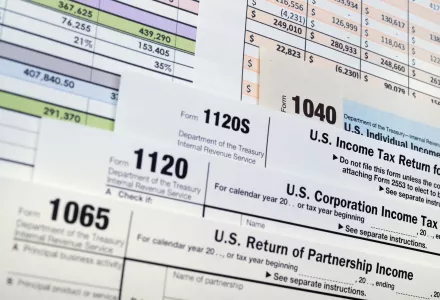
Tax credits for research and development are a means of incentivizing the private sector to invest their own resources on challenging problems. However, in practice, the fungibility of tax credits and other monetary elements can lead to misalignment between the public good represented by R&D and the actions of the company.
In this policy brief, we consider the existing mechanism of tax credits. We see how they can encourage private sector risk-taking to enable research and development (R&D) outcomes. However, our goal is to go beyond economic growth benefits, and to include the less tangible considerations of public good and public purpose in the research and development domain. We then suggest an expansion of tax credits focused on supporting the researchers involved in the R&D and encouraging innovation in both large organizations and in startups and small businesses. This approach builds upon the existing framework of agency-led, mission-defined support of the private sector used by the U.S. government, as occurs in other programs such as America’s Seed Fund (sometimes known by its acronyms, SBIR and STTR). The integration of specific agency- and mission-focused elements to the credit system ensures that these additive credits support research and researchers whose R&D outcomes will improve the health, prosperity, and opportunity for the U.S. as a whole.
Specific means of implementing this public-purpose R&D credit system under existing authorities within the executive branch are suggested, along with the public-facing mechanisms for creating and maintaining the evaluation approach of what constitutes “public purpose” as science and society progress.
Our suggested approach is summarized as:
- Using the existing framework of the Small Business Administration-managed, U.S. R&D agency directed and funded (“lead agency”) approach of America’s Seed Fund, allow for U.S. agencies and departments to augment their support of helpful research and development by enabling private sector entities that cooperate and coordinate their R&D to claim an additional “Focused Research Personnel Tax Credit”
- This credit should be limited in scope to reducing the tax burden of companies in proportion to the number of research staff engaged in related research, as determined by the framework provided by the lead agency.
- This tax credit should be transferrable to later years for small or new companies, transferrable under acquisition, and usable as collateral for business loans.
Tax credits for R&D today
The essential thesis of modern R&D tax credits recognizes that trading present tax revenue for future economic growth provides a benefit to the public. In essence, allowing companies to deduct some of their costs of research will improve their economic competitiveness, and in turn benefit the citizens of the host nation. Many companies see the benefits of short term development work given the continuous changes happening as technology evolves and the marketplace1. However, long-term development, blue sky research, and motivations beyond reduction of future costs or increases in competitiveness rarely enter into the decisions where the existence, or absence, of an R&D tax credit makes or breaks the business case. Thus, tax credits for R&D are limited in impact.
Tax credits sit in a very economically-focused portion of the toolbox governments have. This toolbox also contains a variety of other mechanisms to encourage research and development, which also includes non-dilutive investment, contracting mechanisms, and equity ownership as run by the federal government. These latter mechanisms, which typically involve increasing investment and oversight from the government, are usually leveraged from the lens of supporting public purpose integration into emerging technologies. Often one considers the level of government intervention and the level of oversight as a ‘sliding scale’, with entries like tax credits – largely self-reported, private sector driven – on one end and direct government grants through research funding mechanisms on the other.
However, this theory of tax credit, and its application, have shown only a limited ability to connect the pathways of R&D to other areas of benefits for the citizens of the country, including health, jobs, and a better standard of living. It also does not account for, or support, developments that are focused on improved ethical outcomes and collective outcomes. Finally, it often provides preference to existing firms that have revenue, which enable claim of tax credit compared to early stage startups, and can crowd out the space.2
As a case in point, the R&D leading to improved advertising focus and the highlighting of controversial posts on social media qualifies for the existing tax credit. Yet current events suggest that the economic growth it may provide is outweighed by the negative externalities it imposes, from misinformation to misuse of labor.3
On the other hand, we recognize that the alignment between profit motive and public purpose is rarely perfect; many times, there are intangible or ancillary benefits to doing public purpose R&D that companies can reap that go beyond near term profit.4 When using tax credits as a non-invasive means of supporting R&D for public good, our approach should focus in improving the incentive for companies to develop with a public purpose in mind, in addition to the profit-motive incentive already implicit in existing tax credits
How do tax credits and other low-oversight R&D incentives sit within the larger framework of an increasingly multinational economic environment? The lack of oversight or nation-driven focus on tax credits, combined with other corporate discounts elsewhere, provide incentives for taking the best credit, which may involve off-shoring research teams or off-shoring the corresponding research outcome, thus reducing the technical expertise and technology economic within the United States, with long-term negative implications for future growth.5 Companies have also developed means for taking government funds through contracts while also claiming tax credits on those costs, under the assumption that this out-sources governmental risk to the companies.
Fundamentally, tax credits for R&D highlight and enable a disconnect between the goals of research and the perspective of the community of researchers executing the research and the interested public. These credits align research goals towards company profit, but has little connection to the aspects of public purpose beyond pure economic growth by design.
These tax credits also sit in the larger space of the role of R&D and the use of cash reserves by corporations, all of which have seen substantial changes in the past decade. Companies are, on their own, claiming more R&D costs, and at the same time, building larger cash reserves. While these reserves can be critical for smoothing unexpected research elements6, we suggest this structural change arises in part due to the overall change in capital markets following the 2008 recession onward that have made finding long-term investments extremely challenging for established firms. The reasons for this change are complex, but the evidence is simple: the continuing existence of negative yields in the bond market, in which companies pay governments so that they can hold cash.7 A deeper investigation is likely warranted on this topic, but for now we will take this as an assumption: that in the absence of external investment opportunities, companies find it beneficial to invest in improving their products and developing new products, both of which activities fit under the accounting rubric of R&D.
Fundamentally, tax credits are only a small portion of the whole space of possible ways to better encourage public purpose outcomes for technology; however, their wide deployment, broad use, and company-driven application with low oversight suggest they are a powerful tool for helping achieve such outcomes.
Our primary findings:
- Research topics that are of public interest and that enable the public good are worthy of a variety of incentives. Tax credits provide a low-friction, bottom-up decision-making approach to encouraging such research.
- Successful mechanisms for improving investment in R&D rely upon the principle of aligned interests across disparate groups, combined with approaches for integration of new communities and modifications of the existing community. Great people form the backbone for these investments, and incentives should align with that concept.
- The process of determining which areas are viable for R&D requires a consistent, and regular, interaction between the public (via political and other means) and the research, innovation, investment, and business communities. Great ideas in the context of public purpose should be vetted through these interactions, and tax credit-based approaches should leverage this vetting.
- Metrics for determining what is R&D and what is R&D success are crucial for the effective investment of tax dollars. However, you become what you measure; thus, it is critical to choose metrics that include economic growth, impact, personnel, and research successes aligned with public purpose goals. We encourage a fundamental pathway for investment around the thesis that great research comes from great people exploring great ideas; tax credits for R&D should reflect these priorities.
A suggested pathway: R&D tax waivers for research personnel
The key question we address here: how do we encourage this application of corporate money towards R&D to include public-purpose in the selection and execution of the research? A simple approach to better align community and public interest in tax credit claims around research and development is to focus the credits on the researchers. After all, the researchers come from, and are responsive to, these communities.
For example, in the Netherlands recent revisions and expansions to tax credit R&D have focused on reducing the cost to companies for the employment of researchers, rather than other costs.8 While money is fungible, one recognizes that this has multiple effects. It ensures the researchers know their efforts are partly tax-payer subsidized. It ensures companies are encouraged to invest in their staff, both in terms of renumeration and also in terms of training. And it complements existing tax credit frameworks, which more typically focus on balance sheet reporting in a business environment with substantial revenue; focusing on researchers instead of revenue enables small startup companies to take better advantage of these incentives.
We suggest complementing this approach with specific mechanisms of determining fields and types of researchers that can qualify for these tax credits. These mechanisms should be responsive to the political and social environment; to the investor, business manager, and other stakeholder concerns; and to the expert scientists and other researchers working in the field more broadly, who can better elucidate future points of concern or trouble.
One approach for enabling and supporting the determination of areas for public purpose-related R&D tax credits would be the existing National Science and Technology Council (NSTC), a body within the White House that coordinates R&D priorities and activities across the federal government. Another approach would be through multi-agency, cooperative efforts, including those that represent public-private partnerships when the membership is a reasonable sampling of the active field, as could occur, for example, in a public purpose consortium (PPC).9
To provide a clear example, consider the creation of a new tax credit schema that enables companies working directly with, or through established public purpose consortia in concert with, U.S. government agencies to be able to have a specific credit for the staff dedicated to their joint research projects. This ‘people-centric’ approach would naturally have the restriction that the staff actually work in the United States, as well as the usual restrictions on companies that might be engaged in such activities to be domestic. It also would leverage recent research showing how providing tax credits for companies directly connected to individual researcher salaries has the added benefit of encouraging domestic hiring in multinational corporations.
Finally, it is critical that new tax credits or existing tax credits can be better leveraged to enable startup and small companies, which often have zero or small revenue and thus no tax basis, to be able to ‘bank’ credits on their balance sheet. This allows them to use such credits as collateral for loans; to have such credits pass on to companies or entities that buy them; and to be able to more fully invest in strong staff and their salaries at the beginning of the process. This approach, as typified by the Keystone Innovation Zone10 in Pennsylvania, can be extended to a Nation-wide approach, with some considerations to ensure that only small companies (less than 50 employees, for example) are eligible. Finally, use of these credits should expire after some date, such as five years; and preference should be given to companies within some period of time of their starting, such as 10 years.
Within the U.S., this approach could be implemented through inclusion of researcher-related tax credits when applying for a variety of research-focused efforts run through existing U.S. agency and department programs. These include small business funding such as SBIR and STTR; research-related contracts as commonly provided by the Department of Defense; grant-related contracts done through traditional peer review-driven pure research funding; and inclusion of credits when companies partner with non-profit or Government teams in implementing the above, especially when the company’s costs are not being covered by the granting mechanism. For example, when executing cooperative research and development through a CRADA mechanism, the relevant U.S. agency working with their private sector partner could effectively grant a number of such researcher tax credits to the partner.
We note that certain elements of this approach are already reflected in recent IRS rulings, as per notice 2017-23.11 That preliminary approach enables a reduction of FICA-related taxes (payroll taxes, covered by the employer in U.S. tax law) as an R&D credit for small and medium businesses. However, our approach which includes the valuation of tax credits beyond payroll tax and including them as assets with respect to future sale or purchase would dramatically increase its applicability. On the other hand, connecting these additional developments to other agency actions, such as support for the program via either grant programs or through a public purpose consortium, adds a public purpose rubric to the evaluation of such credits, and thus enables better outcomes and focus of the associated research and development.
To summarize, we suggest:
- Keep the existing R&D tax credit infrastructure, but find means to supplement it for public purpose benefits.
- Provide guidance on public purpose R&D areas and targets via interagency coordination, such at the National Science and Technology Council (NSTC) reports and via public-private partnerships such as public purpose consortia (PPC).
- Enable departments, agencies, and collective government-private sector entities such as consortia to provide a personnel-based tax credit or waiver when supporting identified public purpose R&D.
- Use existing interagency coordination bodies to track the outcomes of R&D personnel tax waivers and other incentives on a rolling basis to evaluate success and to enable refactoring or other changes to public purpose R&D areas and targets.
- Enable such tax credits to be available for valuation, collateral, and transfer upon acquisition for pre-revenue startup companies and small businesses, as already established in regional development activities.
- Use existing frameworks, such as the SBIR and STTR programs, to enable effective administration of these credits by a central agency such as the Small Business Administration while letting agencies and departments develop and direct individual programs.
Measuring success
Critically, these ideas should be tested. For example, with the creation of the National Artificial Intelligence Initiative, there is a unique opportunity to build this type of contracting or researcher-focused tax credit into the program as various U.S. agencies develop and execute their collective vision for the field.
We also recognize that metrics of success for this type of program can vary widely from field to field. Following the adage “you become what you measure”, we encourage a focus on measuring the quality and quantity of research staff that are claimed under tax credits, along with their nominal areas of research. Collecting this information through the tax credit process provides insight for the government and ensures that companies focus on getting technical leaders and staff involved wherever possible. This may have the additional effect of raising researcher salaries, as the effect of the subsidy may be to increase the number of job openings in emerging fields, as they become comparatively cheaper to hire in terms of corporate bottom lines. For example, the Netherlands applied an R&D tax incentive and found a wage effect of 25%. Companies had chosen to use their tax incentive towards recruitment of top notch scientists, thereby increasing their wages spending less on R&D itself.12
At the same time, this effort should have well-defined timelines for phase-in and phase-out, so that decision makers, and researchers, are fully aware of the risks to areas of research as particular areas phase out in eligibility for this type of tax credit. We also note that there remains the goal of increased economic activity and economic growth, as paid for in part by these expanded tax credits. However, measuring this type of success requires long baselines and may be hard to build into the program from the start. We encourage this as a future-looking element of any program.
Notes
1 https://www.thefabricator.com/tubepipejournal/article/shopmanagement/how-industry-40-is-transforming-the-modern-workplace-with-the-rd-tax-credit
2 https://www.nber.org/papers/w26099 and the summary https://mitsloan.mit.edu/ideas-made-to-matter/state-level-rd-tax-credits-create-startups-dont-help-them-succeed
3 The case is eloquently made in Shoshana Zuboff’s The Age of Surveillance Capitalism, 2020; efforts around fake news are widely reported, such as here: https://www.scientificamerican.com/article/information-overload-helps-fake-news-spread-and-social-media-knows-it/
4 E.g., https://esrc.ukri.org/news-events-and-publications/evidence-briefings/public-support-for-business-r-d/
5 For a counter-example, see https://www.swinburne.edu.au/media/swinburneeduau/research/research-centres/cti/working-papers/CTI-Working-Paper-2-16-Thomson-and-de-Rassenfosse.pdf
6 Brown and Petersen, Journal of Corporate Finance, 17, 694-709 (2010). DOI: 10.1016/j.jcorpfin.2010.01.003, https://lib.dr.iastate.edu/cgi/viewcontent.cgi?article=1010&context=finance_pubs
7 See, e.g., https://www.frbsf.org/economic-research/publications/economic-letter/2019/october/yield-curve-responses-introducing-negative-policy-rates/
8 https://www.oecd.org/sti/rd-tax-stats-netherlands.pdf
9 https://www.belfercenter.org/publication/public-purpose-consortium-enabling-emerging-technology-public-mission
10 https://dced.pa.gov/programs/keystone-innovation-zone-tax-credit-program/
11 https://www.irs.gov/pub/irs-drop/n-17-23.pdf
12 Lokshin and Mohnen, Research Policy, 42, 823-830 (2013), https://econpapers.repec.org/article/eeerespol/v_3a42_3ay_3a2013_3ai_3a3_3ap_3a823-830.htm
Taylor, Jake. “Supporting a Public Purpose in Research & Development: The Role of Tax Credits.” June 2021




